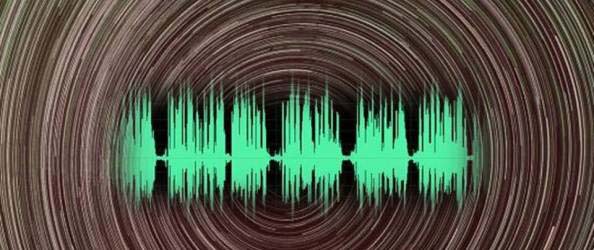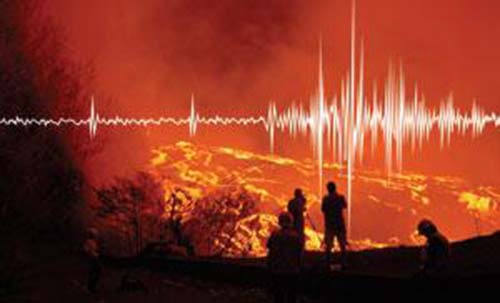

The Hum is a phenomenon, or collection of phenomena, involving a persistent and invasive low-frequency humming, rumbling, or droning noise not audible to all people. Hums have been reported around the planet. The classic description of the Hum is that of a distant idling diesel engine. Typically, the Hum is very difficult to detect with microphones, and its source and nature are hard, if not impossible, to localize. In some cases, a specific source has been located or suggested.
Hums have been reported all over the world, especially in Europe. The Hum is sometimes prefixed with the name of a locality where the problem has been particularly publicized: e.g., the "Bristol Hum", the "Taos Hum", the "Windsor Hum" (Canada), the "Bondi Hum" among others. A Hum on the Big Island of Hawaii, typically related to volcanic action, is heard in locations dozens of miles apart. The local Hawaiians also say the Hum is most often heard by men.
Those who can detect the Hum have been referred to as "hearers", "sensors", "hummers", and "humlings". The term "hearer" appears most frequently in the literature. Data from the Taos Hum study suggests that 2% to 5% of the general population can detect the Hum, with individuals 50 years of age or older being particularly prone to sensing it.

An ongoing low-frequency noise, audible only to some, is thought to originate somewhere near this town and is consequently sometimes known as the Taos Hum. Those who have heard the Hum usually hear it west of Taos near Tres Orejas. The Taos Hum was featured on the TV show Unsolved Mysteries, and it was also briefly mentioned in an episode of The X-Files.
It is during the 1990s that the Hum phenomenon began to be reported in North America and to be known to the American public, when a study by the University of New Mexico and the complaints from many citizens living near the town of Taos, New Mexico, caught the attention of the media. However, in the 1970s and 1980s, a similar phenomenon had been the object of complaints from citizens, of media reports and of studies, mostly in the United Kingdom but also in other countries such as New Zealand.
It is difficult to tell if the Hum reported in those earlier cases and the Hum that began to be increasingly reported in North America in the 1990s should be considered identical or of different natures. During the last decade, the Hum phenomenon has been reported in many other cities and regions in North America and Europe and in some other regions of the world.

Researchers from the USArray Earthscope have tracked down a series of infrasonic humming noises produced by waves crashing together and thence into the ocean floor, off the North-West coast of the USA. Potentially, sound from these collisions could travel to many parts of the globe. No mechanism has been suggested to explain how the Hum is heard in the middle of remote land masses, hundreds of miles away from any ocean.
Scientists capture Earth's 'hum' on ocean floor PhysOrg - December 7, 2017
Scientists have long known earthquakes can cause the Earth to vibrate for extended periods of time. However, in 1998 a research team found the Earth also constantly generates a low-frequency vibrational signal in the absence of earthquakes. Since then, seismologists have proposed different theories to explain the existence of this continuous vibration, from atmospheric disturbances to ocean waves moving over the sea floor. They've also measured the vibration using seismometers on land, but had not yet successfully measured it at the sea floor, which could help scientists better quantify the sources of the vibrations. Now, using seismic instruments on the bottom of the ocean, researchers have successfully quantified Earth's vibrational "hum". A new study published in Geophysical Research Letters, a journal of the American Geophysical Union, determined at the ocean bottom the frequencies at which the Earth naturally vibrates, and confirmed the viability of using ocean instruments to study the hum.
Earth's Mysterious Hum Explained Live Science - April 14, 2015
Is the hum linked to ocean waves? Even planets can get a bad case of tinnitus, according to a new study that explains Earth's mysterious, never-ending hum. Scientists have long known that earthquakes can make the Earth sing like a bell for days or months. However, in the late 1990s, seismologists discovered that the world also constantly vibrates at very low frequencies even when there are no quakes. This so-called microseismic activity is too faint for humans to feel. Now, researchers say ocean waves are the culprit behind these mysterious tremors. But neither idea could account for the entire range of vibrations seen on earthquake sensors. The new study combines both these ideas into one model that accounts for these microseismic signals.
The essential element that defines the Hum is what is perceived as a persistent low-frequency sound, often described as being comparable to that of a distant diesel engine idling, or to some similar low-pitched sound for which obvious sources (e.g., household appliances, traffic noise, etc.) have been ruled out.
Other elements seem to be significantly associated with the Hum, being reported by an important proportion of hearers, but not by all of them. Many people hear the Hum only, or much more, inside buildings as compared with outdoors. Many also perceive vibrations that can be felt through the body. Earplugs are reported as not decreasing the Hum. The Hum is often perceived more intensely during the night.
Some people perceive the Hum continuously, but others perceive it only during certain periods. For some people, the perceived Hum can represent a faint sound and a mild annoyance, while for others who perceive the Hum's sound and/or vibrations more intensely it represents a nuisance that can seriously interfere with daily activities. Common consequences include a lack of sleep, as the Hum can keep some people awake or wake them in the middle of the night. Such cases have given rise to the expression "Hum sufferers."

In the Unsolved Mysteries segment called 'Mystery Hum', a tape recreation of the Taos Hum was used for this segment. Robert Stack reported that one of the "Hum sufferers" created the audio tape, mainly for the purpose in that particular segment. This was done since their audio equipment didn't pick up low-frequency sounds very well, and so that the show's viewers and other non-"Hum sufferers" would get an idea of what the actual auditory phenomenon sounded like.
On November 15, 2006 Dr Tom Moir, of the University of Massey in Auckland, New Zealand, made a recording of the Auckland Hum and has published it on the university's website. The captured hum's power spectral density peaks at a frequency of 56 hertz.

A suggested diagnosis of tinnitus, a disturbance of the auditory system, is used by some physicians in response to complaints about The Hum. Tinnitus is generated internally by the auditory and nervous systems, with no external stimulus. However, the theory that the Hum is actually tinnitus fails to explain why the Hum can be heard only at certain geographical locations, to the degree those reports are accurate. There may exist individual differences as to the threshold of perception of acoustic or non-acoustic stimuli, or other normal individual variations that could contribute to the perception of the Hum by some people in the population and not by others.
While the Hum is hypothesized by some to be a form of low frequency tinnitus such as the venous hum, some sufferers claim it is not internal, being worse inside their homes than outside. However, others insist that it is equally bad indoors and outdoors. Some people notice the Hum only at home, while others hear it everywhere they go. It is commonly reported that it is made worse by soundproofing (e.g., double glazing), which serves only to decrease other environmental noise, thus making the Hum more apparent. Tinnitus, as well, is generally worse in places with less exterior sound.
People who both suffer from tinnitus and hear the Hum describe them as qualitatively different, and many hum sufferers can find locations where they do not hear the hum at all. An investigation by a team of scientists in Taos dismissed the possibility that the Hum was tinnitus as highly unlikely.

Human ears generate their own noises, called spontaneous otoacoustic emissions, which about 30% of people hear. The people that hear these sounds typically hear a faint buzzing or ringing, especially if they are otherwise in complete silence, but most people don't notice them at all. However, these emissions occur with equal frequency across age groups within the population, and the Hum typically occurs in regional clusters, and rarely within large metropolitan areas.

Global tectonic plate movement is causing an increase in earthquake activity, especially in the Pacific Ring of Fire.
This is all part of global earth changes.

Government experiments of various kinds mentioned in conspiracy theories

In the case of Kokomo, Indiana, a city with heavy industries, the origin of the hum was thought to have been traced to two sources. The first was a pair of fans in a cooling tower at the local Daimler-Chrysler casting plant emitting a 36 Hz tone. The second was an air compressor intake at the Haynes International plant emitting a 10 Hz tone. After those devices were corrected, however, the Hum persisted.
Canada to Study Mysterious 'Windsor Hum' Live Science - January 23, 2013
Some people have described the sound as a low, humming drone. Others say it changes into a heavy "whump, whump, whump" sound. Still others have compared it to the bass rumblings of soul singer Barry White. But whatever the mysterious sound known as the "Windsor Hum" is compared to, the residents of this small city in Ontario, Canada (directly adjacent to Detroit) agree that it's driving them bonkers.
Hums have been reported in other parts of the world for years. The Taos Hum has bedeviled residents of the northern New Mexican town for decades. Bristol, England, Aukland, New Zealand and Bondi, Australia have all been plagued by unexplained booming, buzzing or droning noises. These hums have been blamed on seismic events, underground lava or industrial equipment. And the Earth itself is known to make a hum, generated by a number of events including the rumbling of storm-driven ocean waves. Researchers now believe the Earth's hum can help them analyze the composition of our planet's interior. No other hum, however, has set off an international diplomatic kerfuffle like Windsor's. Preliminary analyses have led investigators to believe the source of the hum is on or near Zug Island, an industrial area on the Michigan side of the international border, the Wall Street Journal reports.